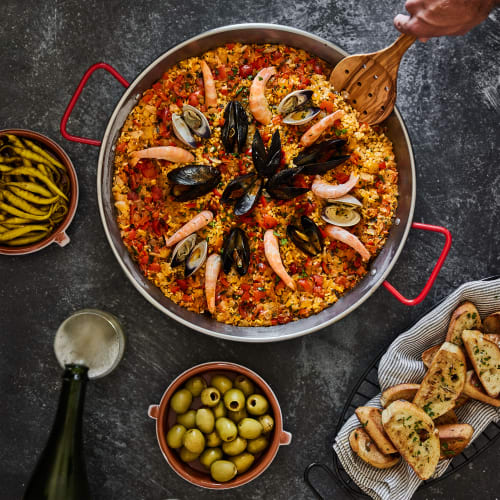The Best Rice for Paella: A Culinary Guide
Jonathan Harris | May 2025




Paella is Spain’s famous rice dish, celebrated for its vibrant flavors and communal appeal. Originally a simple meal created by farm workers in the rice fields of Valencia, paella is now enjoyed around the world. In a lot of ways paella represents the best of Spanish culture; it is a dish of pure flavors that is meant to be shared, from recruiting family and friends to help with the preparation, to when it is served from a single pan.
Our family has cooked countless paellas, and each one is an adventure. Experimenting with a variety of ingredients is always fun, from fresh local seafood to Ibérico pork to wild mushrooms. But rice is the soul of paella, and one ingredient that makes all the difference.

What Kind of Rice is Best for Paella
The world has hundreds of varieties of rice. You may have several in your kitchen now – each one suited for a particular dish. Long grain American rice works well with New Orleans gumbo. Basmati rice from India is the perfect base for curry. So, it makes sense to turn to Spain for the rice you need for authentic paella.
Rice is the foundation of paella, absorbing the rich flavors of the broth, saffron, and other ingredients. Short-grain rice from Spain is ideal for paella, because it can absorb a lot of liquid while maintaining its firm texture. Long grain rice won’t absorb the flavors, while other short grain rices, like Arborio, release starch and result in a creamy (dare I say mushy?) paella.
Bomba Rice
Bomba rice is a rare breed, rescued from obscurity by chefs in Spain. It is regarded as the ultimate rice for paella because its slow growing grains are particularly dense and absorb the most broth without overcooking or becoming soft. Bomba rice is difficult to grow and matures more slowly, so it tends to cost more than other varieties.
Calasparra Rice
Calasparra rice, cultivated in the Murcia region, is another excellent option. It is named after the mountainous Calasparra region, with rice paddies fed by cool water from an irrigation system introduced by the Moors. This microclimate means that the rice grows slower, with a denser grain, so that it excels at absorbing flavors while remaining firm and separate. It is particularly well-suited for achieving the coveted "socarrat," the crispy layer at the bottom of the paella pan.
Calasparra is a truly artisan rice, tended by hand by local farmers in a remote valley. Organically grown and pesticide free, rice from Calasparra is protected by rigorous Denominación de Origen standards. Just 1% of Spanish rice comes from this special region making it a rare gem of Spanish cuisine.

Senia and Bahia Rice
Senia and Bahia are traditional short-grain rice varieties from Spain that are also very good for paella. Primarily grown in the extensive rice paddies near Valencia, these varieties are the most typical paella rice. These rice types absorb more liquid than average. Though not as exceptional as Bomba or Calasparra, they are the everyday go-to rice for paella cooks in Spain.
Beware of Substitutes
Selecting the right rice is crucial for a delectable paella. Bomba and Calasparra rice are the top choices due to their superior flavor absorption and texture. Senia and Bahia rice offer quality traditional alternatives. While you may be tempted to use Italian short grain varieties like Arborio and Carnarol, these rices are not good choices for paella. And typical long grained rice won’t absorb all the complex flavors.
What Rice Do We Use for Paella?
I am a big fan of Bomba paella rice. I’ve cooked dozens of paellas, and Bomba always cooks perfectly and is forgiving for the chef. Plus, it has a great texture. My brother, Tim, prefers Calasparra rice. He thinks it is more of a classic paella rice, and he wants to show off his skill without the help of Bomba.
We both agree that cooking with real Spanish paella rice is fundamental to an authentic paella.
¡Buen provecho!

¡Hola! I'm Jonathan Harris, one of the owners of La Tienda. I love sharing insights about Spain's amazing food culture.
Learn more >
Related Articles

